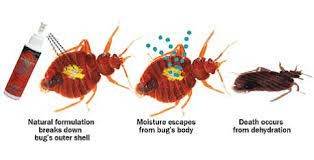Bed bugs have spread like wildfire across the US and other parts of the world since their re-emergence. Bed bug statistics show they’re in all 50 states in the USA and developed countries like Canada and the UK. This leaves one wondering why they are so hard to kill even though recent pest treatment technologies are advanced.
This post highlights and explains several reasons bed bugs are challenging to kill. Understanding these challenges puts you in a better position to treat bed bug infestations.
Table of Contents
Bed bugs are hardy survivors.
Bed bug history suggests that they are incredibly hardy survivors. They survived the mass extension of dinosaurs and re-immerged in massive numbers after nearly being wiped out in the 1950s to 1990s. DDT was an effective tool against bed bugs before it was banned owing to its catastrophic environmental and health effects.
Bed bugs are small, reddish-brown insects that feed on the blood of humans and animals. They are challenging to detect and control because of their small size and ability to hide in hard-to-reach areas such as cracks and crevices. Some familiar hiding places for bed bugs include the following:
- Behind wallpapers and picture frames
- Along baseboards
- Under floorboards
- Inside electrical outlines
- Inside bed frames and other pieces of furniture
They have adaptive exoskeletons
Scientific research suggests that today’s bed bugs have exoskeletons that are 15 times stronger and more resilient than their predecessors. Bed bug history shows that today’s bed bug exoskeletons differ from those that existed 20 years ago when DDT was at the center stage of treatment. Evolved exoskeletons put them in a better position to repel treatments that would otherwise kill them.
Most treatments kill bed bugs by wicking out moisture from their bodies and inducing a state of dryness. Desiccants, for example, work by destroying the waxy exoskeleton of a bed bug. The bed bug will gradually dehydrate and die without an exoskeleton to protect its moisture content. Moisture-wicking treatments are ineffectual against modern bed bugs because their thick exoskeletons allow them to withstand the dehydrating impact.
Bed bugs have developed resistance to many pesticides and insecticides, making chemical treatments less effective. Their exoskeletons evolved to have high levels of enzymes, such as esterases and oxidases, that can break down these chemicals. Therefore, non-chemical treatment options such as heat are more effective for controlling bed bug infestations.
Bed bugs are high-volume breeders
Female bed bugs spend most of their lives pregnant, meaning that if you pick up a single bed bug, it will multiply immediately. You should also consider that a one-bed bug can lay up to 500 eggs in its short lifetime. To get a clear picture of the seriousness of the situation, you should multiply the number of eggs in a lifetime by the approximate number of female bed bugs in your home.
Bed bug populations grow at an explosive pace. They are often undetectable before infestations manifest. When you combine these factors, you’ll have thousands of bed bugs in weeks. The difficulty of treating bed bugs successfully increases with the rise of their population in your home. This means it is best to install bed bug monitoring tools that help detect infestations early.
Bed bugs can go without food for a long time
Bed bugs enjoy a good blood meal at night as you blissfully sleep. This, however, does not mean they will die if they don’t feed regularly. An adult bed bug can stay in hibernation for up to 550 days without food under optimal conditions. Attempts to get rid of bed bugs by starving them will be unsuccessful. Instead, they will feed on you more aggressively when you return home with the misled notion that they are dead.
A bed bug consumes 200% of its body weight in one meal. This means they can cause severe health effects after a long period of starvation. Their bites are painless because their saliva contains anesthetic. They will multiply back up by the time you notice an infestation.
Bed bugs are immune to common bed bug treatments
Scientific research shows that bed bugs have developed immunity to Neonicotinoids and pyrethroid compounds. Most people rush for over-the-counter pesticides and insecticides when they uncover a bed bug problem in their homes. Frustration will kick in after several failed treatments and thousands of dollars lost to over-the-counter chemical treatments.
Most EPA- approved pesticides for treating bed bugs have Neonicotinoids and Pyrethroids. This means most common chemical treatments approved for killing bed bugs will not deliver your desired results. Consider using non-chemical treatments such as heat instead of rushing for expensive chemical-based over-the-counter treatments.
Bed bugs are mutants
Scientific research shows that many of today’s bed bugs have genetic mutations that make them insecticide-resistant. These genetic mutations are responsible for bed bug resistance to common over-the-counter pesticides in retail stores. The researchers involved in the study suggested that the new genes are responsible for better detoxification, and chitin is expressed after a bed bug’s first meal.
Bed bugs also possess genes from a parasitic bacterium known as Wolbachia and other bacteria within its species. Apart from the genetic mutations, over 400 species of bacteria live inside and outside a bed bug’s body. Bed bugs share a symbiotic relationship with these bacteria because they help keep the bugs alive by fighting viruses, pesticides, and other harmful substances.
Final Thoughts
Considering that bed bugs are tough to kill, you may wonder whether you can successfully eliminate them. Even though these bugs are resistant to pesticides, there are new and innovative non-chemical treatment solutions, such as cryonite. You can also settle for pocket-friendly traditional solutions. For example, you can use your washing machine and dryer to treat washable items and vacuum to remove bed bugs.

